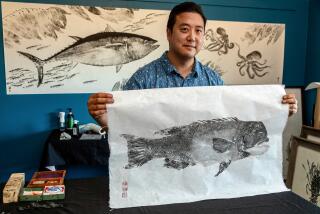Woodcarver Has Wealth of Sea Life in His Roots
- Share via
A redwood pelican stands proudly in a corner of the patio at Barney Kuntz’s sprawling house on the slope of Mt. Helix.
It is the first attempt by Kuntz, a 73-year-old retired Air Force colonel, to carve a pelican, and it was inspired by his discovery of a piece of wood that reminded him of the sea bird’s body.
Although woodwork has always been a hobby with Kuntz, he didn’t begin woodcarving until 1982. His son, who carves marine animals in Oregon, got him interested in the art form.
Kuntz may consider woodcarving a hobby, but what works he doesn’t give to family and friends he sells for up to $2,500 apiece.
“I like it better than woodwork because it’s more relaxing and creative,” he said. “It’s creative, because I don’t copy other works. I carve from photographs or from memory. I never make two pieces that are alike.”
Kuntz does his carvings mostly from driftwood left from the roots of the redwood, as well as white cedar, both of which he purchases.
“The root of the redwood is dense and heavy, and, when finished, it looks like rosewood, which is hard and colorful,” he said.
So far, he said, he has carved about 300 pieces, some of which are found throughout the house above Spring Valley where he has lived for 15 years.
Keeping the pelican company on the patio are three reddish-brown variations of sea lions, as well as a walrus. Over the kitchen counter hangs a wooden macaw.
In fact, all of the artwork in the house was created either by Kuntz or one of his three children. In the living room stands a sandhill crane, a large sea lion, a dolphin and another pelican. Kuntz’s wife, Edith, said she won’t part with those pieces.
Kuntz is a member of the California Carvers Guild, which sponsors a show each month. In 1983, his sea lion and dolphin won first place in the novice class in one of the shows.
The animal sculptures are half life-size, but the birds are full size, Kuntz said.
“I take a lot of pictures at Sea World and the zoo to get the very shape and position of the animals,” he said. “Whatever the shape of the wood is, I have to follow that shape, and the grain of the wood to maintain its strength. If I go across the grain, the wood would break.”
Kuntz goes wood shopping with an idea of the shape he wants to create. Before carving, he takes a chain saw or a hatchet to the rough edges of the redwood. He gets rid of the soft material on the outside and looks for the hardwood below. Once he sees what he has to work with, he begins to shape the piece using chisels. He usually rubs several oils on the completed carving to brighten the natural mahogany color.
Kuntz said he spends about four hours a day in his workshop at the side of his house.
His works can be seen at the Tarbox Gallery in San Diego and the Mole Hole in La Jolla.
More to Read
Sign up for The Wild
We’ll help you find the best places to hike, bike and run, as well as the perfect silent spots for meditation and yoga.
You may occasionally receive promotional content from the Los Angeles Times.






